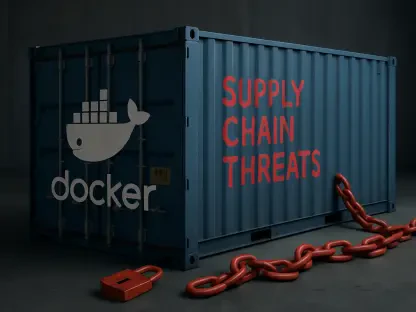In the high-stakes arena of cybersecurity, Security Operations Centers (SOCs) are grappling with an unprecedented deluge of threats, compounded by overwhelming alert volumes and a workforce stretched thin by burnout. The integration of Artificial Intelligence (AI) offers a beacon of hope, promising to redefine how threats are detected, analyzed, and mitigated in real time. A groundbreaking advancement by eSentire, a leading cybersecurity firm, showcases the transformative power of Anthropic’s Claude AI model within its Atlas XDR Platform. This innovation has slashed the time for comprehensive threat investigations from five grueling hours to a mere seven minutes, marking a staggering 43x improvement in speed. Such a leap forward is not merely a technological feat but a fundamental shift in the operational dynamics of SOCs, addressing long-standing pain points like delayed responses and analyst fatigue. Beyond the impressive metrics, this development signals a broader trend in the industry toward leveraging AI to enhance efficiency and accuracy. It sets the stage for a deeper exploration of how such technology can reshape workflows, empower human expertise, and fortify defenses against increasingly sophisticated cyber threats.
Revolutionizing Threat Investigations with Unmatched Speed
The integration of Claude into eSentire’s Atlas XDR Platform has redefined the pace at which SOCs can respond to potential threats, achieving results that were once unimaginable. By orchestrating complex, multi-tool workflows and synthesizing thousands of data points from diverse sources like endpoint telemetry, network traffic, and cloud environments, this AI model replicates the analytical prowess of seasoned SOC analysts but at an accelerated, machine-driven speed. What used to consume five hours of meticulous investigation now takes just seven minutes, allowing organizations to contain threats before they can escalate into full-blown crises. This dramatic reduction in time not only enhances operational efficiency but also fundamentally alters the economics of cybersecurity, enabling SOCs to handle higher volumes of alerts without requiring proportional increases in resources or staff.
Equally striking is the precision with which Claude operates, ensuring that speed does not come at the expense of reliability. Through extensive testing across 1,000 varied scenarios—including ransomware attacks and lateral movement tactics—the AI has demonstrated a 95% alignment with the decision-making of senior analysts. Furthermore, it achieves an impressive 99.3% threat suppression rate on first contact, underscoring its capability as a dependable tool in high-pressure environments. This balance of rapid response and high accuracy positions Claude as a pivotal asset, ensuring that SOCs can trust the technology to deliver consistent, actionable insights during critical moments of threat detection and response.
Amplifying Human Capabilities Through AI Integration
Rather than aiming to replace human analysts, Claude serves as a powerful force multiplier, augmenting their skills and alleviating the burden of monotonous tasks. By automating repetitive processes such as alert triage and evidence collection, the AI frees up SOC teams to concentrate on more strategic endeavors like advanced threat hunting and long-term security planning. Insights from eSentire’s leadership highlight that this approach enhances overall team performance, allowing analysts to engage with complex challenges that require human intuition and creativity. The result is a more dynamic and motivated workforce, better equipped to tackle the evolving landscape of cyber threats with confidence and clarity.
This synergy between AI and human expertise also fosters a more sustainable work environment within SOCs, where the grind of routine tasks often leads to dissatisfaction. With Claude handling the bulk of time-intensive, low-level investigations, analysts can dedicate their energy to high-impact activities that directly contribute to organizational security. This shift not only boosts morale but also ensures that critical expertise is applied where it matters most, creating a balanced operational model. As cybersecurity demands continue to grow, such integration proves essential in maintaining a resilient and adaptable defense posture without sacrificing the invaluable human element at the core of SOC operations.
Addressing Persistent Challenges in SOC Operations
SOCs are often overwhelmed by a relentless flood of alerts, with daily volumes reaching up to 10,000, of which a staggering 80% can be false positives. This sheer quantity means that only a small fraction—typically 22-25%—of alerts are thoroughly investigated, leaving potential threats undetected and vulnerabilities exposed. The integration of Claude into eSentire’s platform directly tackles this issue by automating the initial stages of alert processing, drastically cutting down investigation times and ensuring that critical threats are prioritized. This efficiency helps SOCs manage their workload more effectively, reducing the risk of missing significant incidents amidst the noise of irrelevant notifications and enhancing overall threat visibility.
Beyond alert overload, analyst burnout remains a pressing concern, with over 70% of SOC professionals reporting exhaustion due to repetitive tasks and fragmented workflows, often exiting the field within months. Claude’s automation of manual processes offers a vital reprieve, lightening the load on analysts and helping to curb turnover rates. With the demand for security analysts projected to grow by 33% over the next decade, according to the U.S. Bureau of Labor Statistics, such technological interventions are crucial for retaining talent. By creating a less stressful and more rewarding work environment, AI integration supports long-term workforce sustainability, ensuring that SOCs remain staffed with skilled professionals ready to face emerging challenges.
Evolving XDR Platforms with Deep AI Integration
The adoption of Claude signals a significant evolution in Extended Detection and Response (XDR) platforms, moving beyond standalone security tools to a model of deeply integrated AI capabilities. Unlike isolated solutions that offer limited scope, eSentire’s approach enables dynamic, multi-step investigations tailored to the specific nature of each threat, drawing on vast datasets and historical intelligence. Supported by secure deployment frameworks like Amazon Bedrock, this platform-level integration ensures robust data protection and tenant isolation, particularly for clients in critical infrastructure sectors with stringent compliance needs. Such advancements highlight a future where XDR platforms become central to SOC operations, delivering scalability without the burden of expanding headcount.
This shift toward integrated AI also redefines how SOCs approach resource allocation and strategic planning. By embedding advanced models like Claude directly into the operational fabric, organizations can achieve consistent, high-quality threat analysis without relying on disparate tools that often lead to inefficiencies. The ability to execute around 30 evidence-gathering steps per incident, customized to the threat at hand, exemplifies the precision and adaptability of this model. As cyber threats grow in complexity, the move to platform-integrated AI within XDR systems offers a forward-thinking solution, equipping SOCs with the agility needed to stay ahead of adversaries in an increasingly hostile digital environment.
Building Stronger Defenses Through Network Effects
A key advantage of Claude’s integration is its ability to harness network effects, amplifying the impact of threat intelligence across a broad ecosystem. By analyzing data from eSentire’s extensive customer base of over 2,000 organizations, the AI identifies emerging threat patterns and actor behaviors, applying these insights proactively to bolster defenses. This collective learning approach often outpaces commercial threat feeds by 35% and detects novel threats 12% of the time, providing a significant edge in preemptive security measures. Such capabilities ensure that when an attack is mitigated for one client, the resulting knowledge strengthens protections for all, creating a unified front against cyber adversaries.
This collaborative defense mechanism is particularly vital for sectors like critical infrastructure, where the stakes of a breach are exceptionally high. The ability to share and act on real-time intelligence across multiple domains not only enhances individual organizational security but also fortifies the broader cybersecurity landscape. As threats become more interconnected and sophisticated, leveraging network effects through AI-driven platforms offers a scalable way to address systemic risks. This interconnected approach underscores the importance of moving beyond siloed defenses, fostering a resilient community of organizations better prepared to counter the evolving tactics of malicious actors.
Pioneering a New Era in Cybersecurity Operations
Reflecting on the strides made through the integration of Claude into eSentire’s Atlas XDR Platform, it’s evident that a new chapter has unfolded in cybersecurity operations. The dramatic reduction in threat investigation times, coupled with near-human accuracy, tackles inefficiencies that once plagued SOCs, setting a benchmark for future innovations. The focus on enhancing rather than replacing human expertise ensures that analysts remain central to strategic efforts, while network effects strengthen collective defenses across diverse sectors. As organizations navigate escalating cyber risks and persistent talent shortages, the adoption of platform-integrated AI emerges as a critical step forward. Looking ahead, the challenge lies in expanding these capabilities to address even more complex threats, ensuring that scalability and security evolve in tandem. Embracing such technologies, while fostering collaboration and continuous improvement, stands as the next vital move for SOCs aiming to maintain a robust posture against adversaries.









